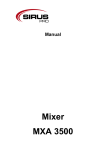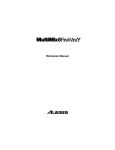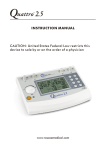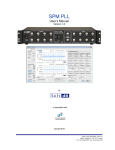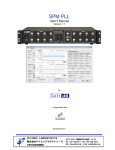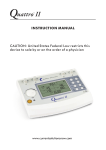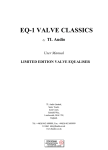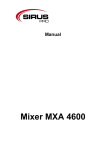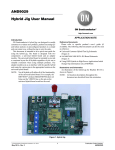Download Manual (english)
Transcript
Manual EKON 8/12/16 Table of contents 1. Features ........................................................................................................................................... 3 2. Safety instructions ............................................................................................................................ 3 2.1. FOR SAFE AND EFFICIENT OPERATION ............................................................................ 3 3. Mono input channel .......................................................................................................................... 5 4. Stereo outputs .................................................................................................................................. 7 5. Master .............................................................................................................................................. 8 6. MP3 .................................................................................................................................................. 9 7. Back view ....................................................................................................................................... 10 8. Specifications ................................................................................................................................. 10 9. Troubleshooting.............................................................................................................................. 11 10. Block diagram ............................................................................................................................ 14 2 / 15 1. Features • 8/12/16 Mono (MIC) channel inputs • 48V phantom power switch • Built-in 16 DSP effect • 2 groups • 2 AUX send (AUX 1 send pre-fader, AUX 2 send post-fader) • 2 band EQ (100Hz-12kHz) • True balance XLR output • Phones and monitor output • RCA input and Record input • Highly accurate 10 segment 3-color meter • 60mm Fader • MP3 player with USB-and SD-slot and LCD display 2. Safety instructions • Read the safety instructions and also this manual carefully. • Keep the manual. • Observe all red flags. • Observe the manual. • To prevent fire or electric shocks, protect the device against rain and humidity • Pull the plug before opening the housing. • To prevent an electric shock you should not remove the cover. • Do not operate the device in the near of water. • Use only a dry cloth for cleaning. 2.1. FOR SAFE AND EFFICIENT OPERATION Be careful with heat and extreme temperature Avoid exposing it to direct rays of the sun or near a heating appliance. Not put it in a temperature bellow 41°F /5°C, or exceeding 95°F /35°C. To avoid placing on un-stable location Select a level and stable location to avoid vibration. 3 / 15 Do not use chemicals or volatile liquids for cleaning Use a clean dry cloth to wipe off the dust, or a wet soft cloth for stubborn dirt. Pull the plug before cleaning. If out of work, contact sales agency immediately Any troubles arose, remove the power plug soon, and contact with an engineer for repairing, do not open the cabinet by yourself, it might result a danger of electric shock. Take care with the power cable Never pull the power cable to remove the plug from the receptacle, be sure to hold the plug. When not using the device for an extended period of time, be sure to disconnect the plug from the receptacle. Transport The console should be transported either free-standing or in an appropriate case. The console should be protected during transport with foam or similar shock-absorbing materials. So you can avoid damages. Hearing To avoid hearing damages, you should not operate a sound system with high levels. This applies to monitor systems, which are in the near of the ear, headphones or IEMs also. Important Damages caused by the disregard of this user manual are not subject to warranty. The dealer will not accept liability for any resulting defects or problems. Make sure the electrical connection is carried out by qualified personnel. All electrical and mechanical connections have to be carried out according to the European safety standards. 4 / 15 3. Mono input channel 1. Balance input (MIC) Electronically balanced inputs accept a standard XLR male connector. 2. LINE-input The unbalanced LINE input is provided for the use of an unbalanced mic or to accept an unbalanced high impedance input signal (e.g. Deck, turntable, keyboards…) 3. GAIN With this button you can adjust the input sensitivity of each channel. 4. PK This LED will light when the signal level approaches clipping at any of the three monitored points: pre-EQ, post-EQ or post-fade 5. -20dB If this switch is pressed the input signal will be lowered by 20dB. 6. Equalizer HIGH: With this control you can raise or lower the highs. At the beginning the control has to be set on 12 o’clock position. Clockwise turning raises the highs, counterclockwise turning lowers the highs. MID: It is a bell shaped filter; with it you can raise or lower the signal by 15dB around the center frequency. The center frequency can be set between 249Hz and 6 kHz. Q = 1. LOW: With this control you can raise or lower the lows. At the beginning the control has to be set on 12 o’clock position. Clockwise turning raises the lows, counterclockwise turning lowers the lows. 5 / 15 7. AUX 1/AUX 2 FX The AUX are pre-fader and post-EQ. Normally they are used for foldback or monitor speakers, which need to be controlled separately from the main P.A. 8. PAN With this control you can change the distribution of volume on the channel R and L or the groups 1 and 2. If the control is set on the middle position, both sides get the same signal portion. Turning clockwise raises the signal portion of channel R or group 1, counterclockwise for L or group 2. 9. MUTE Press this switch to turn the channel signal off. The large red LED lights if is muted. 10. MAIN This is the main control switch. If this switch is not pressed there is no output. 11. SUB The main group control switch. If this switch is not pressed there is no output. 12. PFL You can monitor only the signal of this channel on your headphones by pressing PFL. 13. Channel fader With it you can control the volume of the channel. 6 / 15 4. Stereo outputs 1. MIX OUT The mix left and right outputs are sent from the XLR sockets as balanced signals. 2. SUB The SUB output jack. 3. AUX OUT AUX 1: This is an impedance balanced phone-jack type output. This jack outputs the signals from AUX (AUX1) bus. You can use this jack, for example, to connect an effect unit, cue box, or other monitoring system. AUX 2: This is an impedance balanced phone-jack type output that outputs the signals from AUX2 bus. You can use this jack, for example, to connect an effect unit. Note: The channel fader can adjust the level. 4. AUX RET: MONO L/R These are unbalanced phone-jack type line inputs. The signal received by these jacks is sent to the MIX L/R buses and the AUX 1 (AUX 2) bus. These jacks are typically used to receive the signal returned from an external effect device (reverb, delay, etc.) Note: These jacks can also be used as an auxiliary stereo input. If you connect the L (MONO) jack only, the mixer recognize the signal as monaural and will send the identical signal to the L and R jacks. 5. PHONE This is used for monitoring the master signal and individually monitoring each channel with PFL. 6. MIX BALANCE OUT Left/Right master out balanced interface. 7. 2TK IN These two RCA phone sockets are unbalanced left and right line-level inputs, used for connecting a playback device. 8. REC OUT These two RCA outputs carry a copy of the MIX L and MIX R signals. Here you can connect a recording device. 7 / 15 5. Master 1. DIGITAL EFFECT DISPLAY 2. PHONE This is used for monitoring the master signal and individually monitoring each channel with PFL, L/R 6 G1/G2. 3. PARAMETER With this control you can adjust the effect parameter such as depth, speed and so on. All the parametric levels will being resetting 4. AUX 1 This is used for adjusting the built-in effect level send to AUX bus. Note: The built-in effect level which is sent to AUX bus is not controlled by EFFECT fader. 5. SEND This is used for adjusting the volume of AUX 1. 6. AUX 2 FX This is used for adjusting the volume of AUX 2. 7. EFFECT Fader This fader is used for adjusting the effect output level of built-in/external effect units for each channel. 8. AUX RET This is used for adjusting volume of AUX sound, when sending AUX signal to used jack. 9. POWER LED & Level meters POWER: This LED lights when the mixer is on. PFL: This LED lights when the PFL is activated. +48V: This LED light, when the phantom power for each mono cannel is activated. 10 segment LED level meters: The level of the output is displayed on the 10 segment level meters. If level shows PEAK, please lower the output level. 8 / 15 10. MIX/SUB to PHONES-Taste If the switch is pressed the signal of the SUB is send to phones, if it is not pressed the phones get the signal from the MIX. 11. MIX/SUB to 2TK/MP3-Taste If the switch is pressed the signal of the SUB is send to 2TK/MP3, if it is not pressed it gets the signal from the MIX. 12. /13. TO L/R These are two select switches for the group signal send to the MIX or SUB output. When they are pressed, the group signal is send to MIX output. 14. SUB 1&2 Fader Here you can set the output volume of SUB 1&2. 15. MIX L/R Fader Here you can set the output volume of MIX L/R. 6. MP3 1. PLAY/PAUSE With this key you can start or break the playback from USB/SD/MMC. 2. PREV/VOLWith this key you can search backward and reduce the volume of the MP3 player. Push it once to search the previous track, push it more than 3 seconds to reduce the volume of the MP3 player. 3. NEXT/VOL+ With this key you can search forward and add the volume of the MP3 player. Push it once to search the next track, push it more than 3 seconds to add the volume of the MP3 player. 4. MP3 Player MODE Here you can choose if the player should repeat all files or only one file. (All file repeat 9 / 15 ). 5. Display Shows which song is played. 6. USB DISK 7. SD CARD SLOT 7. Back view 8. Specifications Tone Nominal input level Fader down -85dBu MIC 2,4kΩ LINE 11kΩ Stereo input 100kΩ Max. output level 18dBM (1kHz, THD = 0, 5 %) S/N Ratio 71dB THD <0,007% Frequency Response 20Hz-20kHz +/-0,5dB Headphone output max. level 300mW/200Ω EQ mono channel HF 12kHz +/-15dB MF 2,5kHz +/-15dB LF 80Hz +/-15dB Power consumption <30W Power supply 100-240V/50-60Hz 10 / 15 9. Troubleshooting Symptoms Cause Solution Mixer is not plugged in or turned on. Plug in the mixer and turn it on. Channel levels are too low. Turn up channel levels. Control room level is turned down. Turn up the control room level. The appropriate signal hasn’t been assigned to the control room out. In the master section of the mixer, be sure the right switch is selected. Check outputs to make No sound from the mixer Cable is not plugged into sure cables are plugged output jack. in. Headphones are not Plug headphones into plugged into phone jack. phone jack. Monitor or headphone amplifier is turned off or Turn amplifier on or up. down. Bad cable. Check all cables. Channel level is too high. Set channel levels correctly. Channel input level is too high. Turn down your instrument to a normal volume and then set the channel levels. AUX RET level is too high. Low the level of AUX RET in the master section of the mixer. Audio signal is distorted. Turn down the L/R MIX level control in the L/R MIX level is too high. master section of the mixer. Audio signal carries an unwanted hum. Too much low-level noise in the mix. Engage the channel’s high-pass filter by pressing the -20dB switch. Interference from Engage the channel’s 11 / 15 appliances such as air conditioners. Not using TRS cables. Phantom power is not turned on. Microphone level is too low. Turn on the phantom power using the switch on the rear panel of the mixer. Turn up channel level. Turn up the instrument‘s volume control. If problem persists, check Instrument volume is too the instrument by low. plugging headphones into the instrument’s phone jack. ^Gain is too low. Adjust the channels gain control. Effects level is too low. Turn up the level using the EFFECTS LEVEL control in the master section of the mixer. An effect has not been selected. Press the EFFECTS knob on the desired effect and make sure the SIG indicator is lit. Effect processor is not plugged in or turned on. Make sure that the unit is plugged in and turned on. Internal effects are not working External effects are not working. Make sure you are using 1/4ˈˈ TRS cables. Test the microphone or other audio devices. If Microphone is damaged. you detect damage, contact the manufacturer or dealer. Channel level is too low. No or low sound from a channel. high-pass filter by pressing the -20dB switch. 12 / 15 LED meters are not working. No Power. Aux outputs of mixer are not connected to inputs of processor or processor’s outputs are not connected to mixer’s outputs. Make sure that the mixer outputs are connected to the processor’s inputs and the processor’s outputs are connected to the mixer’s aux inputs. Mixer’s effects return signal is too low. Turn up the output of the effects processor or turn up the mixer’s EFFECTS LEVEL in the master section. Nothing is routed to the HDPH/CTRL RM output. Press the desired MIX or 2TK TO MIX button. Incorrect or defect power supply. Replace with correct power supply (only use recommended AC output power supply). 13 / 15 10. Block diagram 14 / 15 Importer: B & K Braun GmbH Industriestraße 2 D-76307 Karlsbad www.bkbraun.com [email protected] 15 / 15
















